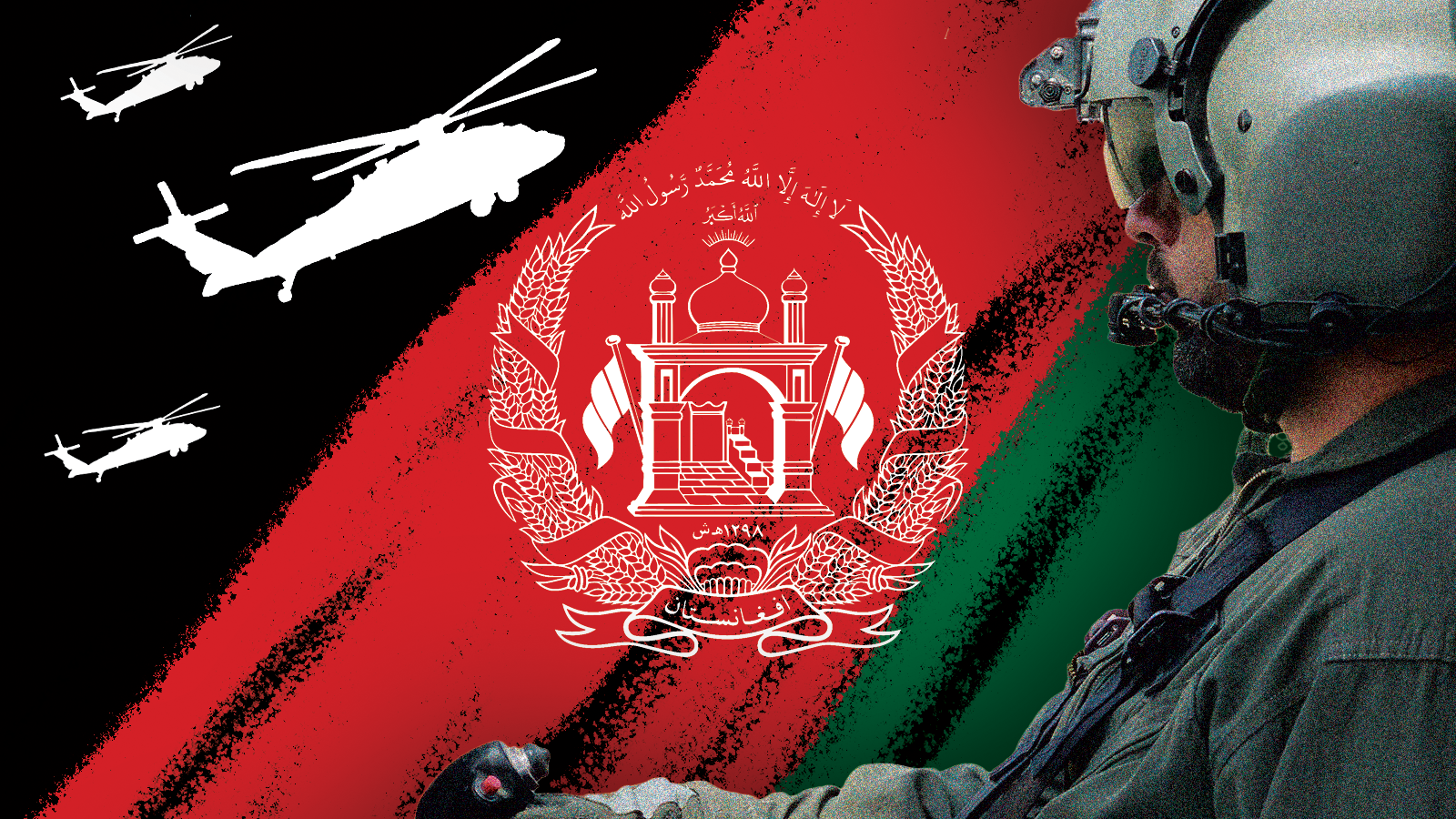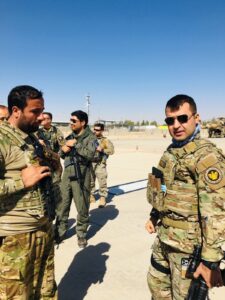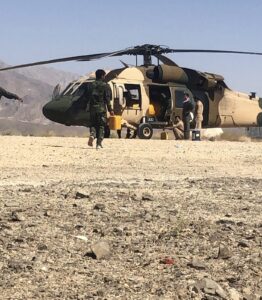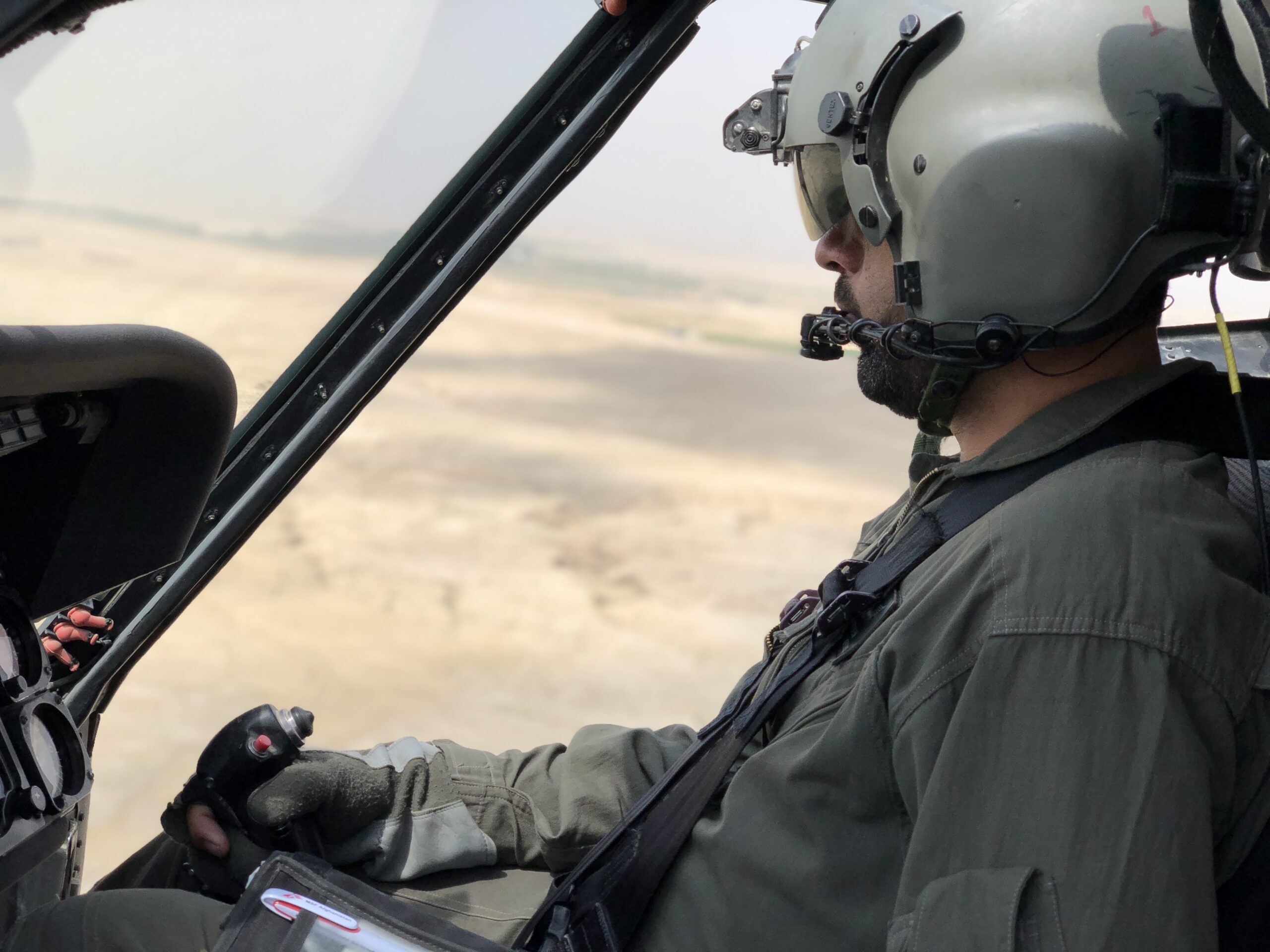
Col. Salim Faqiri reflects on his escape from Afghanistan, one year later. (Pilot photo courtesy Salim Faqiri; Graphic by Breaking Defense)
WASHINGTON — Over the summer of 2021, battles against the Taliban took Afghan air force Col. Salim Faqiri and his UH-60 Black Hawk from Lashkar Gah to Kandahar to Kabul. One by one, he watched those cities fall. Even after Afghan President Ashraf Ghani fled the country on Aug. 15, Faqiri was committed to stay and fight on behalf of his country.
He and several other Black Hawk pilots took their families and flew to the country’s Panjshir valley, one of the last remaining footholds for resistance fighters. But when Faqiri arrived, he realized for the first time just how hopeless the situation had become. While there were aircraft available, there were no weapons for them, and the resistance forces were poorly equipped. The war he had fought for more than a decade was all but over.
Faqiri — who is now 32 years old — had joined the Afghan air force in 2010, after graduating school and receiving additional instruction to improve his English. His father was a member of the old Afghan army, rising to the rank of colonel before the Taliban took over the country in 1996. The younger Faqiri wanted to “fight terrorists” and help ensure that fate never occurred again.
But now, history was repeating itself.
On Aug. 17, 2021, Faqiri made the decision to leave his homeland, potentially forever. But in some ways, there was no decision to be made at all. Faqiri had spent his adult life fighting the Taliban, and by staying, he would be sentencing himself and his family to a life of being hunted.
“I just took my wife and two kids and I put them on the Black Hawk … and we came to the Kabul airport,” he said. “There was no time for thinking of others.”
From Hamid Karzai International Airport, Faqiri boarded a US Air Force C-17 with his wife and his young daughters, leaving behind dreams of a better Afghanistan for which he’d fought for so long.
“I felt frustrated, and I felt like a loser,” he told Breaking Defense last week, on the eve of the one-year anniversary of America’s withdrawal from Afghanistan. “It was a hard decision, and I never wanted this to happen. And it happened.”
Faqiri is just one of the more than 120,000 people who were brought out of Afghanistan last August in the hopes of finding safety. Now living in Arizona with his wife and three daughters — one who was born earlier this month, who may never know the Afghanistan her father fought for — Faqiri finds himself struggling to adjust to life in America, and still wondering how the US government could seemingly desert so many innocent Afghan people.
The Gradual Fall
The Trump administration reached a peace agreement with the Taliban on Feb. 29, 2020, after months of negotiations. Under the deal, the United States would have 14 months to withdraw troops from Afghanistan, and the government of Afghanistan would release 5,000 Taliban prisoners of war.
Meanwhile, the Taliban vowed to stop attacking US troops, agreed to release 1,000 Afghan security personnel it had captured and promised that it would no longer provide Afghanistan a safe haven for insurgent groups to plot attacks against the US, whether among its own members, al-Qaida or other groups.
However, the deal had several major flaws. For one, the peace agreement did not require that the Taliban stop attacking the Afghan military, nor did it lay out a plan for peaceful coexistence of the existing Afghan government and the Taliban.
President Joe Biden delayed the date of the US withdrawal from May 1, 2021 to the end of August 2021, buying the Afghan military a little more time under US support. However, he ultimately opted to end the war, claiming during an address last August that the only “real choice” was “between leaving [Afghanistan] or escalating” combat operations by deploying additional American troops.
Faqiri — a commander of a UH-60 Black Hawk wing, who had also operated Russian Mi-17 helicopters during his decade in the Afghan air force — said he first noticed the rise in Taliban activity around January of 2021, about the same time US-provided supplies began to diminish. The situation turned dire by the summer, as the Taliban had taken over many of Afghanistan’s districts, with only major cities under the control of the Afghan government.

Afghan air force Col. Salim Faqiri, left, speaks with Afghan Army Lt. Gen. Sami Sadat during a January 2021 meeting in Helmand province. (Courtesy of Salim Faqiri)
The single biggest military advantage the Afghan forces had over the Taliban was air power. Any hope Kabul had of controlling territory once the US left rested on control of the skies. The problem is that the Taliban knew this too, and acted quickly to stymie the air force.
As the Taliban took over territory, they set up highway checkpoints that effectively blocked the Afghan military from being able to resupply its forces from the ground. As the United States pulled Western defense contractors from the region — and attempts by US military advisers and contracted personnel to assist Afghan maintainers via Zoom calls and teleconferencing proved unsuccessful — more and more aircraft became unflyable, making it difficult for Afghan forces to commit airlift assets for resupply missions.
By June, only four of Afghanistan’s 33 Black Hawks were flyable. “Most of them had battle damage or had maintenance issues, but [at] the same time there was nobody to fix it,” as most Afghan maintenance personnel did not have adequate training to be able to repair the helicopters without oversight from US defense contractors, Faqiri said. This situation persisted into August.
Faqiri said he and other Afghan air force officials repeatedly shared their concerns with US advisers in daily Zoom calls, but the situation only grew worse as the service was weakened by neglect — and targeted killings by the Taliban.
By July, at least seven Afghan air force pilots had already been assassinated by the Taliban in a series of off-base killings, Reuters reported at the time. On Aug. 7, an Afghan UH-60 Black Hawk pilot was killed when a bomb attached to his vehicle was detonated.
The Taliban, in its announcement taking credit for the attack, named the pilot as Hamidullah Azimi, but his real name was Hamidullah Habibi, and he was a pilot under Faqiri’s command.
“He was on the way to join me in Helmand but the Taliban killed him. I wrote a letter to his family but I couldn’t give it to them because everything happened so quickly,” Faqiri said. “He had four teenage sisters and three brothers. … I [would] say to them how brave he was and how much work [he has] done for his family and his country.”
At that point Faqiri already knew that the Taliban was targeting him, and he couldn’t go home to see his family, which had previously gone into hiding.
Before Kandahar fell in mid-August, Faqiri watched as the Taliban slowly encroached into the city, launching attacks on Afghan bases. “The Taliban was so close to the Kandahar base that we saw them on camera, with a drone,” he said. But when Faqiri asked an Afghan air force general for permission to strike the Taliban, he was told that they had no guided munitions left and that using dumb bombs would risk civilian casualties.

Afghan air force Col. Salim Faqiri and other members of the Afghan air force refuel a UH-60 Black Hawk during a Aug. 14, 2021 flight to Kabul, after the fall of Kandahar. Airmen used a small fuel tank to refuel the helicopter in Daykundi, which still remained under control of the Afghan government. (Photo courtesy of Salim Faqiri)
As the Taliban closed in, Faqiri and his family moved to Kabul, and then finally to Panjshir, before making the decision to evacuate the country on Aug. 17.
Faqiri said he knows that many Americans believe that Afghan security forces gave up and ran. What they don’t understand, he said with audible frustration, is the destruction of morale that occurred over months, as Afghan security forces saw fellow soldiers die as weapons dwindled and aircraft became inoperable, making it much more difficult for the military to rescue troops who had been wounded in battle. In his mind, the collapse could have been avoided altogether had the Afghan military been better resourced, with the logistics pipeline necessary to keep its US-provided equipment running.
“I witnessed a lot of fighting like in Helmand, Kandahar. … I flew every day, every night and saw what’s going on,” he said. “It wasn’t like, in one or two weeks, the collapse happened. … The collapse happened and started months before.”
The Exit And The Aftermath
Faqiri and his wife carried with them only a “small handbag… with a few diapers” when they boarded the C-17 that would take them and their two daughters — then aged three and one-and-a-half years — to Qatar.
In Qatar, Faqiri and his family found themselves sitting in a hangar with thousands of other refugees. For his daughters, it was a shock. “They didn’t know what happened to them, why it happened so quickly,” he said.
But amid the chaos of the fall of the Afghan government, Faqiri was constantly busy, seeking to connect his roster of Black Hawk pilots with a group of Americans trying to facilitate safe passage to the United States. This group, who called themselves “Operation Eagle,” was comprised primarily of US Black Hawk pilots who had formerly instructed forces in Afghanistan, as well as other national security professionals.
“There was no process created yet,” said Maggie Caroline Feldman-Piltch, one of the members of Operation Eagle who helped connect the Afghan families with food, shelter and other necessities once they had landed in the United States.
“The pilots had their documents taken from them a long time ago. The documentation that they did have with them, we needed to make sure that it was going to be accepted by TSA,” she said. Some of the pilots made the call to flee Afghanistan while actively flying what turned out to be their final missions, leaving behind spouses and children; they would eventually arrive in the US still wearing their flight suits, with literally just the clothes on their backs.
Faqiri arrived in the United States on Aug 20, 2021. In just five days, he had gone from dedicated to the fight to living in a new country, with no family or legal papers that would guarantee his right to stay in the United States. With help from Operation Eagle, Faqiri and his family found temporary housing at a hotel in Washington. By the time the US ended its evacuation effort on Aug. 30, he had helped 68 Black Hawk pilots safely evacuate Afghanistan and come to the United States.
Of the 35 pilots who remained in Afghanistan, some continued to try to thwart the Taliban, living on the run and working alongside resistance forces. Others never had that option, and were forced into delivering Black Hawks to the Taliban and working for the organization, Faqiri said.
“It was 16 August. [One pilot] took one of the Black Hawks. He was supposed to follow me on to Panjshir, but he didn’t. He changed the heading [of the aircraft] … and joined with the Taliban,” he said. “He got a call [from the Taliban]: ‘If you want to go, that’s your choice. We will kill your brothers and torture your family.’ He didn’t have a choice.”
Asked what Afghanistan will look like a year from now, Faqiri said his homeland’s future is “very clear.” The Taliban will renege on the promises they made to the US government in the peace deal and Afghanistan will revert to being “home for training all the terrorists,” with the Taliban likely to provide safe haven for groups like al-Qaida to operate there, he said. (Despite the agreement from the Taliban not to host al-Qaida, the terrorist group’s leader, Ayman al-Zawahiri, was living in Kabul when he was killed in an Aug. 2, 2022 drone strike by the US.)
As to the remains of Afghan’s once-proud air force, government entities and watchdog organizations agree the Taliban will seek to make use of its assets for control of the country.
The Taliban hopes to reconstitute the air force “to suit its needs,” wrote the lead inspector general in a quarterly report to Congress earlier this year. The Taliban claim to have 40 operational aircraft — including two Black Hawks — it captured from the Afghan air force after its takeover of the country, all of which have been observed flying, according to a May report by the United Nations.
The report contends that “flying these aircraft has propaganda value for the Taliban, but little military utility. For the few aircraft in service, the Taliban lack parts, trained mechanics to maintain them and, most importantly, pilots to fly them.”
However, Faqiri is more circumspect, stating that the Taliban could “definitely” use the old Afghan air force equipment if they receive foreign help from a country like China or Russia.
A New Life, But Not A Better One
Since moving to Arizona, Faqiri has found a job — a hard-won achievement, as he had no US-based work experience. His wife, who doesn’t speak English, is taking care of their three daughters, including a baby girl born just a few weeks ago. Adjusting to life in America hasn’t been easy, and the family is still waiting to be granted asylum.
“We started a new life here. This is different and difficult and, still, we are struggling,” he said.
Faqiri dreams of a better future for himself and his family. He hopes to send his eldest daughter to preschool soon, and perhaps one day she will attend university, he said. Faqiri’s own goal is to eventually start college and reenter the aviation industry, where he can use the skills he’s honed over the past decade.
But the memories of those left behind in Afghanistan still weigh heavily upon him.
“The families of the Afghan security forces who died in the fight alongside the Americans — they are right now in Afghanistan, and the Taliban are still punishing their families,” he said, with a mix of sadness and anger.
“That is very frustrating for the Afghan security forces. We fought alongside with the coalition, [against] the [groups] who were the enemy of the United States. But when it comes to our enemy, who are the Taliban and ISIS, [the United States] made a deal with the Taliban. They forget us.”

Afghan air force Col. Salim Faqiri pilots a UH-60 Black Hawk. (Courtesy of Salim Faqiri)
Lockheed Martin projects potential $1 billion loss on classified program
Lockheed CFO Jay Malave said the company currently expects the program to become profitable on an annual basis around the 2028 timeframe.


























